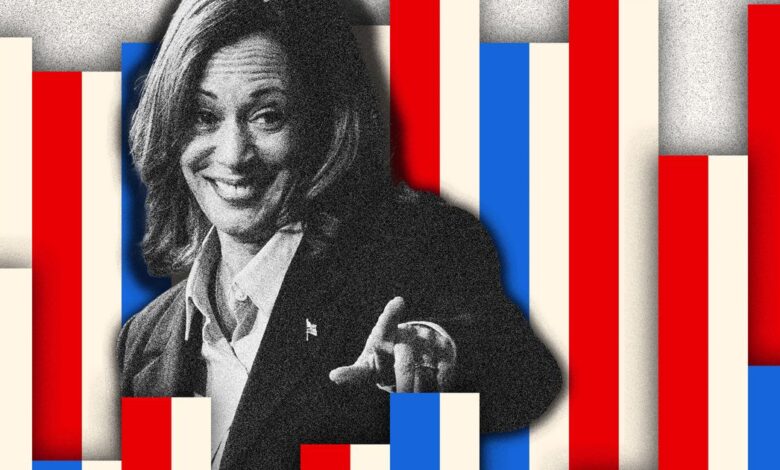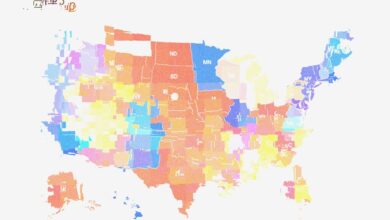

Photo-Illustration: Intelligencer; Photo: Getty Images
In what has turned into a real barn burner of a presidential contest, there’s one metric that stands out as a Kamala Harris advantage over Donald Trump: her personal “favorability,” which is really a polling term for popularity. She wasn’t all that popular as Joe Biden’s 2024 running mate, posting a favorable-unfavorable ratio of 36.8 to 52.7 percent (according to the FiveThirtyEight polling averages) on July 20, the day before Biden dropped out of the race and endorsed Harris. Now her ratio is 46.4 to 46.8 percent, or essentially even. If being as popular as she is unpopular sounds like a rather limited accomplishment, it’s good to keep in mind that very well-known politicians are rarely the public’s favorite people. Trump’s favorable-unfavorable ratio is 42.9 to 52.6 percent, and that represents a modest improvement for him compared to his numbers earlier in the year (mostly attributable, it seems, to sympathy stemming from his survival of an assassination attempt). Joe Biden’s favorability ratio is even worse, at 39.8 to 55.0 percent. No wonder Team Trump wants to do everything it can to depict Harris as a repackaged version of her White House boss. It probably won’t matter much if at all to voting decisions, but it cannot make the former president’s camp happy that his running mate, J.D. Vance, has not endeared himself to the electorate (his favorability ratio is 33.9 to 44.1 percent), while his opponent Tim Walz has the rare distinction of an above-water ratio (39.9 to 35.3 percent).
Superior popularity (or if you prefer, relatively low unpopularity) is not, to be clear, any sort of guarantee of victory. In 2016, Trump defeated Hillary Clinton despite holding a significantly worse favorability ratio (per Gallup, 36 to 61 percent) than his opponent (47 to 52 percent). And in 2020, Trump came very close to winning despite again trailing his opponent in favorability (Trump’s ratio was 41 to 57 percent compared to Biden’s 46 to 50 percent, again according to Gallup). In both cases, of course, the Republican lost the national popular vote (by 2.1 percent in 2016 and by 4.5 percent in 2020).
But there was something else going on underneath the surface in the two previous elections involving Trump: In 2016, so-called “double haters” (voters with an unfavorable opinion of both candidates) represented a robust 18 percent of the electorate, and Trump won them by 17 points. He won the double haters by the same margin in 2020, but they dropped to only 3 percent of the electorate. Earlier this year, the percentage of voters disliking both major-party candidates was actually matching or exceeding 2016 levels, but Kamala Harris’s advent as the Democratic candidate changed that situation quite a bit. A mid-August Monmouth poll showed the percentage of double haters dropping by more than half (to a manageable 8 percent) with Harris replacing Biden, and this time the Democrat was winning over half of them (with only 11 percent favoring Trump and roughly a third refusing to support Harris or Trump). So thanks to her relatively strong popularity, Harris has been able to emerge as the likelier lesser-of-two-evils candidate in a less unstable and unhappy electorate.
That could change by November, of course, but in a contest that will unquestionably involve a high level of negative campaigning, likability could turn into credibility among swing voters and perhaps give Harris the benefit of some doubts.
Otherwise, the polls are showing what can only be described as a dead-even contest as early voting begins. Again using FiveThirtyEight averages, Harris leads Trump by 3.2 percent nationally (47.2 to 43.9 percent); her lead was 2.9 percent the day the DNC began. It is widely anticipated that because of a slight Republican lean in the battleground states collectively, Harris will need to win the national popular vote by something over the bare minimum in order to win the election (just as Biden did and Clinton didn’t). Nate Silver estimates the odds of Harris winning tipping in her favor at somewhere between a 2 and a 3 percent popular-vote margin.
A look at polls in the individual battleground states confirms the picture of a race too close to call. The two states most often cited as probable “tipping point” states deciding the outcome couldn’t be much closer. Harris leads in Georgia by 0.5 percent (46.4 to 45.9 percent) and in Pennsylvania by 0.9 percent (46.2 to 45.2 percent). Two recent polls (from CNN and from Emerson) testing both states showed the candidates tied in Pennsylvania and Harris ahead by a spare point in Georgia. Other battlegrounds are raging as well, with Trump leading in Arizona by 0.3 percent (45.8 to 45.5 percent) and in North Carolina by 0.4 percent (46.2 to 45.8 percent), while Harris leads in Michigan by 2.2 percent (46.5 to 44.3 percent), in Nevada by 0.7 percent (45.9 to 45.2 percent), and in Wisconsin by 3.4 percent (47.6 to 44.3 percent). If Harris were to win all the states where she is currently leading, she’d have 292 electoral votes and a new gig in the White House. But flip the basically tied Georgia and Pennsylvania, and Trump would have 281 electoral votes and the presidency.
Soon enough, we will all be anxiously watching the polls to see if the one currently scheduled presidential candidate debate on September 10 breaks open this crazy-close race or if it instead goes down to the wire.
Source link




